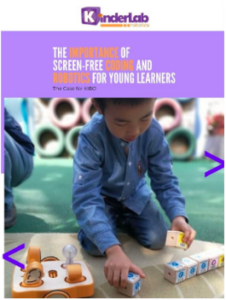eSchoolNews: Teaching Preschoolers to Love STEAM
In this eSchoolNews article, the team at Brooklyn Preschool of Science describes how they use KIBO within their centers. The preschool believes in hands-on learning, rooted in inquiry and discovery. This article shares how they use KIBO throughout their curriculum to bring lessons to life. “For us, the beauty of robotics goes back to power of inquiry, to discovering hands-on activities that connect so many different dots and inspire kids to take joy in exploring their world.”
The article reads in part:
“When we take out the KIBO robot for the first time each October, their eyes light up. It looks like a toy, and they want to touch it. They want to play with it, so they’re more likely to listen to the basic instructions. We start with very simple commands, talking about how it’s a robot that will do things that we tell it to. Then we get into the idea of coding by telling them that robots are all around us. For instance, we explain that when they put their hands under the faucet to wash them, there’s a code in that faucet that tells the water to come out.
Combining art and science
For Halloween this year, we did a “Five Little Pumpkins” song using five KIBOs. As the song goes along, each pumpkin says, “Oh my, it’s getting late,” and rolls away. We programmed the robots to roll away, used their recording feature to capture the kids’ voices, and also incorporated some art by having them decorate pumpkins and put them on the robots’ art platform. Then we sang the song, and every time it was one of the pumpkins turn to roll away, one of the children would press the button and their robot would roll away while playing their voice recording. It was great seeing the looks on their faces when they realized that they taught that robot to do something just through coding.
Another activity we did this year started with feathers. We had students paint with them to see the differences in the patterns they made. We then dropped the feathers from different heights and gave the kids stopwatches to see which took the longest they hit the floor. So we incorporated math and art, and then the computational thinking aspect came when we converted KIBOs into birds.
The kids decorated the robots with feathers and then, to teach them about migration, we added a map that shows geese flying south to the warmer weather. We spoke about the “V” formation they made, and programmed the robots to “fly” across the room a “V” formation. This led us to talking about how the leader of the pack is the one who helps the other birds, and how they take turns being that leader to make the travel easier and give the other birds lift. So we added a social-emotional lesson, and even some physics.
Looking forward to the spring, we’ll be using KIBO for our unit on simple machines. It’s easy to imagine programming a robot to go up an inclined plane, and we also look forward to finding fun, creative ways to incorporate coding into our unit on plants. We may even incorporate robotics into learning the shapes of letters. So, if we’re learning the letter “P” we’ll have the kids code the robot to actually create that letter.
For us, the beauty of robotics goes back to power of inquiry, to discovering hands-on activities that connect so many different dots and inspire kids to take joy in exploring their world.
Read the full article.



















